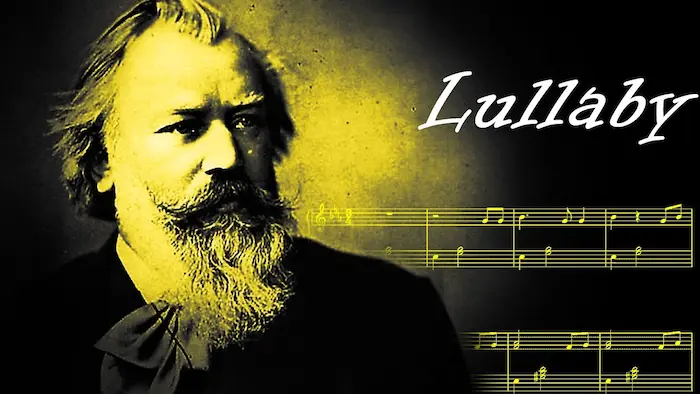Johannes Brahms, a German composer and pianist, created one of the most beloved lullabies in music history. Known as “Brahms’ Lullaby,” this piece has soothed countless children to sleep and remains a staple in the repertoire of classical music. This article will delve into the background, composition, and enduring legacy of Brahms’ Lullaby, providing a comprehensive understanding of its significance.
I. Early Life of Johannes Brahms
Childhood and Musical Beginnings
Johannes Brahms was born on May 7, 1833, in Hamburg, Germany. His father, Johann Jakob Brahms, was a musician who played various instruments, while his mother, Johanna Nissen, was a seamstress. Brahms showed musical talent from a young age. By the time he was seven, he was already receiving piano lessons. His family’s financial struggles meant that Brahms often played piano in dance halls to support them.
Education and Early Influences
Brahms received a solid musical education despite his humble beginnings. He studied piano under Otto Friedrich Willibald Cossel and later Eduard Marxsen. These teachers helped shape his technical skills and introduced him to the works of Bach, Beethoven, and Mozart. These composers profoundly influenced Brahms’ development and style.
II. The Creation of Brahms’ Lullaby
Inspiration and Composition
Brahms composed the “Wiegenlied: Guten Abend, gute Nacht” (Lullaby: Good Evening, Good Night) in 1868. The lullaby was written for Bertha Faber, a friend of Brahms, to celebrate the birth of her second son. Brahms set the text to a traditional folk tune and added his unique harmonic and melodic style. The lullaby’s simplicity and gentle melody make it instantly recognizable.
Lyrics and Structure
The lyrics of Brahms’ Lullaby are based on a traditional German folk poem. The first stanza of the lullaby translates to:
Good evening, good night,
With roses covered,
With cloves adorned,
Slip under the covers.
Tomorrow morning, if God wills,
You will wake once again.
The lullaby’s structure is straightforward, consisting of a simple, repetitive melody that creates a soothing and calming effect. Brahms’ careful attention to harmony and dynamics enhances the lullaby’s serene quality.
III. Musical Analysis
Melodic Elements
Brahms’ Lullaby features a gentle, flowing melody. The melody moves stepwise, with only a few small leaps, creating a sense of calm and ease. The lullaby is typically performed in a slow tempo, adding to its soothing nature.
Harmonic Structure
The harmonic structure of Brahms’ Lullaby is equally simple. The piece is usually in the key of E-flat major, a key known for its warm and mellow sound. Brahms uses basic chord progressions, such as I-IV-V-I, to maintain the lullaby’s gentle and comforting atmosphere.
Dynamics and Expression
Brahms employs subtle dynamics in the lullaby, with many performers opting for soft (piano) and very soft (pianissimo) dynamics. The use of legato (smooth and connected) articulation further enhances the lullaby’s calming effect.
IV. Performance Practice
Vocal Performances
Brahms’ Lullaby is commonly performed as a vocal piece. It is often sung by parents to their children at bedtime. The simplicity of the melody makes it accessible to singers of all skill levels. The lullaby has been recorded by numerous artists, both classical and popular, adding to its widespread appeal.
Instrumental Arrangements
In addition to vocal performances, Brahms’ Lullaby has been arranged for various instruments. These arrangements include versions for solo piano, string quartet, and even full orchestra. Each arrangement retains the lullaby’s gentle character while showcasing different timbral qualities.
V. Cultural Impact and Legacy
Use in Popular Culture
Brahms’ Lullaby has permeated popular culture in various ways. It is often featured in films, television shows, and commercials to evoke a sense of calm and nostalgia. The lullaby’s universal appeal has made it a go-to piece for scenes involving sleep or relaxation.
Educational Significance
In the realm of music education, Brahms’ Lullaby is frequently used to teach young musicians about melody, harmony, and dynamics. Its simplicity makes it an excellent piece for beginners, while its beauty and emotional depth provide valuable lessons for more advanced students.
See Also: 6 Classical Music Pieces Inspired by Swans: All You Want to Know
VI. Conclusion
Johannes Brahms’ Lullaby remains one of the most beloved pieces of classical music. Its simple yet beautiful melody continues to soothe and comfort listeners of all ages. The lullaby’s widespread appeal and cultural significance are testaments to Brahms’ genius as a composer. Brahms’ Lullaby is more than just a piece of music; it is a gift that has been passed down through generations. Its ability to provide comfort and peace makes it a timeless treasure in the world of music. As parents continue to sing Brahms’ Lullaby to their children, they participate in a tradition that spans over a century. This enduring practice ensures that Brahms’ Lullaby will remain a cherished part of our cultural heritage for many years to come.
In summary, Johannes Brahms’ Lullaby is a masterpiece of simplicity and beauty. Its soothing melody and gentle harmonies have made it a timeless favorite in the world of classical music. From its creation as a gift for a friend to its widespread cultural impact, Brahms’ Lullaby continues to touch the hearts of listeners around the world.

